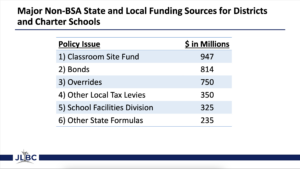Arizona’s newly expanded universal Empowerment Scholarship Account (ESA) program has already empowered tens of thousands of families to pursue better educational opportunities and sparked a nationwide movement to free millions more families from a public education system that’s failing to meet their needs. Yet the usual suspects—left-wing politicians, teachers unions, and their allies in the legacy media—are renewing their war on parents who want to take back control of their kids’ education.
A new memo from the office of Gov. Katie Hobbs, for instance, is meant to spark fear over Arizona’s universal ESA program, using falsehoods and misrepresentations to claim that ESAs are about to send the state’s finances over a cliff. Here are the facts instead:
Claim: “Spending on ESA vouchers could account for 53.25% of all new K-12 education spending in the FY2024 budget going towards only 8% of Arizona students.”
Fact #1: Total spending on universal ESAs students makes up just 2% of total Arizona K-12 spending. ESA awards for all students who’ve joined under the universal category total approximately $350 million, compared to the roughly $15 billion spent on public school students each year. (To date, nearly 50,000 students have joined the ESA program via the universal expansion. At $7,000 per student, this totals $350 million.)
Fact #2: Arizona public school districts are projected to receive over 60% (more than $570 million) of all new K-12 funding in FY 2024, despite making up 0% of the growth in students served this upcoming year. (Districts will receive over 70% of each of the following new state appropriations: $300 million for new “supplemental state aid,” $157 million for inflation increases, $50 million for “additional assistance,” and over $100 million for new school facility construction costs—all in addition to more than $70 million in higher “Classroom Site Fund” revenues.)
Put another way, ESAs and charter schools together are projected to make up 100% of all net new student growth in FY 2024, yet will receive less than half of the new dollars going to K-12 education. As reported by the Arizona Legislature’s Joint Legislative Budget Committee (JLBC), public district schools are slated to serve 7,000 fewer students this year, while public charter schools and ESAs will serve 12,000 and 16,000 more students, respectively. In spite of these trends, Gov. Hobbs’ staffers insist: “We know that public schools continue to overwhelmingly be the first choice of parents in Arizona.”
Fact #3: Even under the Arizona Department of Education’s (ADE) highest projections, the ESA program would be funding the education of roughly 8% of Arizona students (including a disproportionately high percentage of students with severe disabilities) for less than 6% of the total taxpayer cost of educating Arizona’s students. (When looking only at the students joining under the expanded universal category, the cost would be even lower—about 4% of the total spending on Arizona K-12 students.)
Claim: “There is an increased cost to the State when a student leaves a public district school and enrolls in the ESA voucher program. This occurs because the ESA award amount is based on the state funding provided to charter school students, which is higher than the state funding provided to district school students.”
Fact #1: Gov. Hobbs’ office ignores thousands of dollars per student in state and local funding that public school students get that ESA students do not. Every single student attending a traditional public school receives more in funding from state and local taxpayers than that student would receive on the ESA program.
It is true that ESA award amounts are partially tied to the funding level of charter school students (giving 90% of the basic funding formula amount), but ESA students receive 0% of all other state funding that every district and charter school student receives outside that formula.
For example, in addition to the basic K-12 funding formula, state taxpayers pay over $900 per public school student each year via state sales taxes and other sources channeled through the “Classroom Site Fund.” Yet ESA students completely forfeit this funding. Likewise, ESA students receive none of the funding from other state sources that all public school students automatically receive, such as the annual $75 million of supplemental funding from “Prop 123.” Together, these amounts total well over $1,000 in additional formula funding that every Arizona public school student receives, but ESA students do not.
(In addition to these amounts, ESA students will also get none of the extra $300 per student appropriated by the budget this year as “supplemental state aid” that every public school student will receive).
The average savings per ESA student is even higher when including other (non-formula) spending on public school students. In total, JLBC reports over $3 billion (roughly $3,000 per student on average) of additional spending by state and local taxpayers per public school student outside the basic funding formula. ESA students receive none of this funding.
Anti-school choice advocates might argue that these funds do not come out of the state “general fund,” but this is a distinction without a difference when it comes to the impact on Arizona taxpayers. A sales tax surcharge costs state taxpayers just as much, regardless of whether lawmakers put it in a jar called the General Fund or one called the Classroom Site Fund before sending it to public schools.
Gov. Hobbs’ office omits over $3 billion ($3,000 per student) in state and local taxpayer costs per public school student. ESA students do not receive any of these funds:

Claim: “New estimates indicate the ESA voucher program may cost taxpayers up to $943,795,600 annually, resulting in a potential $319,795,600 General Fund shortfall in FY 2024.”
Fact #1: Gov. Hobbs’ office itself does not believe the report that it is using as the basis for these figures. Rather, the governor’s office describes the very same report as “falsely assert[ing]” enrollment and budget impact information and lacking requested background to explain its “methodology and breakdown of current enrollment numbers.”
Fact #2: Gov. Hobbs’ office mistakes the cost ESA awards by thousands of dollars per student. Gov. Hobbs’ team purports to believe that nearly 30,000 more students will join the ESA program this year than previously estimated, at an additional cost of $319 million, or $10,967 per student. But ESA awards for students joining under the universal expansion are just $7,000 each (nearly $4,000 less per student than Gov. Hobbs’ office suggests). Whether willfully or by mistake, Gov. Hobbs’ office conflates the average cost of ESAs when including special education students with the cost of each additional student joining under the universal expansion.
Fact #3: The nonpartisan JLBC continues to project ESA costs in line with the state budget, noting that “any FY 2024 projection is highly speculative. As a result, we will only have a basis for revising ESA projections once we receive actual FY 2024 enrollment figures.”
Fact #4: Even if the higher enrollments and total ESA award amounts estimated by ADE do materialize, they would not represent the net cost to taxpayers of the program. As JLBC explained with less hysterics in response to the same report:
“If ADE’s 100,000 ESA enrollment estimate were to materialize, the department estimates the enrollees would generate $900 million of ESA awards in FY 2024. The $900 million, however, represents the gross cost of all ESA awards and not the net fiscal impact on ADE’s FY 2024 expenses. The net impact would depend on what share of new universal ESA enrollees switched from a public school. Any switchers would result in district/charter savings that would mostly offset the cost of their ESA award.”
In other words, while the total ESA award amounts may continue to increase, the net impact to state and local taxpayers will be a savings in every instance in which a student switches from either a district or a charter school.
As JLBC also notes:
“The overall General Fund net impact of increasing ESA program enrollment may also be reduced if it lowers participation in the individual and corporate income tax credit programs for donations to school tuition organizations (STO)…In FY 2022, STOs provided $218.1 million of scholarships to private school students. If more students opt to participate in the ESA program instead of the STO program, state tax revenues may increase due to declining use of the STO credits.”
Arizona’s ESA program now offers tens of thousands of families an opportunity to pursue the best education possible for their children at a lower cost than traditional public schooling. The governor and her budget office owe it to parents and the public to provide the facts about ESAs free of manipulation.
Matt Beienburg is the Director of Education Policy at the Goldwater Institute. He also serves as director of the institute’s Van Sittert Center for Constitutional Advocacy.










